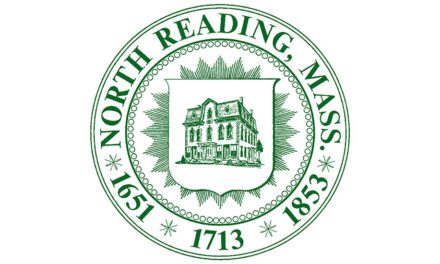Published November 7, 2019
By MAUREEN DOHERTY
NORTH READING — Call it a perfect storm. During routine water sampling of the town’s drinking water supply last August three samples out of seven tested positive for “total coliform.”
Total coliform is a measurement of “bacteria that are naturally found in the soil, in water that has been influenced by surface water, and in human or animal waste,” according to an explanation by the Water Department on the town’s website.
When this occurs, the state Department of Environmental Protection (DEP) protocol triggers an immediate requirement to re-test the samples and take additional samples upstream and downstream of the trigger site within 24 hours of being notified by the lab of a positive test. Fortunately for the town’s water customers, all of these tests came back negative, according to Utilities Superintendent Mark Clark, as has every subsequent routine test performed by the Water Department since the August 6 incident.
Frequent, routine tests are performed three weeks out of every four all year-round, Clark explained to the Transcript.
If any test or retest had indicated the presence of fecal coliform or E. coli, the Water Department would have issued a boil water order, he said, but this has not been necessary because none of those bacteria have been detected.
While the required lab tests were done within the prescribed timeframe following the August 6 sampling, and Clark and his staff also took “a hard look” in examining the town’s entire water system to ascertain any possible source of that total coliform result, per DEP protocol, the paperwork reflecting these actions was erroneously not filed with the state by September 5, within 30 days of the incident.
All municipal water suppliers must meet state and federal guidelines, and part of those guidelines is standardization in the delivery of information to customers. Clark said the reporting protocols changed about five years called the “groundwater rule.”
“It did change reporting requirements and notification requirements. It was a new rule that the federal EPA propagated. The state DEP is under the federal EPA regulations and once there is a change in the federal rules (the DEP) modifies their regulations. They either add to them or modify them based on the changes in the federal law. We are the end recipient of it,” Clark said. He took full responsibility for the filing oversight but assured customers that their water is safe.
Late last week, every water customer in town received a form letter from the Water Department entitled: “Important Information About Your Drinking Water” which triggered confusion among residents and business owners alike.
It was subtitled: “North Reading Water Department Failed to Conduct Required Assessment to Address Coliform Bacteria Contamination of the Water System.” The one-page letter then goes on to explain “What should I do?” “What does this mean?” and “What is being done?” followed by detailed explanations provided by the Water Department to answer those questions plus local contact information.
The letter also stresses the importance of sharing the notification with those who may not receive it directly, as well as making notifications to specific populations, such as those with severely compromised immune systems, infants and some elderly, to seek the advice of medical professionals. It includes the EPA’s Safe Drinking Water Hotline (800-426-4791) as a resource to consult for “general guidelines on ways to lessen the risk of infection by microbes.”
This notice was also published as a legal notice in Transcript.
As Clark explains, the letter contains data and information provided by the town’s Water Department but how the information is presented could not be altered within the state-approved template.
No connection to Reading’s boil water order
Timing in life is everything. Coincidental to the release of this letter to most customers on Thursday and Friday, the town of Reading had a water emergency over the weekend due to a detection of E. coli. This resulted in a blanket notification across multiple platforms starting around 11:20 a.m. Saturday that a boil water order would be in effect in Reading only at least until Monday, Nov. 4, when it was lifted based on the re-tested water samples.
The confusion that resulted on social media and in casual conversation among neighbors doing their Saturday errands, as they saw Reading residents buying bottled water at area stores, left some residents of North Reading believing they too were also under a boil water order. However, this was never the case. Reading and North Reading derive their water from separate sources. Reading is served by the MWRA and North Reading is served mostly by the Merrimack River via the Andover connection — 60 to 70% — with the balance currently provided by the town’s own groundwater wells in the Ipswich River basin.
Town Administrator Michael Gilleberto also weighed in on the matter Monday for the Transcript.
“The Water Department conducts multiple daily, weekly, and monthly inspections or water sampling to monitor the condition of our public water supply. In this instance, the results from three samples triggered further testing which all came back negative,” explained Gilleberto.
“All of the testing procedures were followed, however state reporting requirements were mistakenly not followed. This triggered the October 25 notice being mailed to all water customers,” the T.A. added.
Gilleberto emphasized that “the employees of the Water Department work hard every day to ensure our water supply meets all state and federal standards. This includes working cooperatively with state and federal agencies, and while a report was submitted to the agency involved, it was not submitted in a timely fashion. The notice the Water Department was required to mail to customers is a state-approved template, and we apologize for any confusion it may have caused.”
As a result of the August 6 test result, Clark explained, “If we get any total coliform samples that triggers a couple of things to happen. No. 1, we have to test that same water sample for fecal coliform or E.coli, which is really the ones that would be a problem. If you have ever heard of a ‘boil water order’ something coming back positive for either of those two would have required us to immediately issue a ‘boil water order.’”
“We do seven bacteria samples per week. Three of those (taken) in the first Tuesday in August came back positive for total coliform, so the lab, as part of the state protocol, they take that same water (and) test it for fecal coliforms. None of those three samples came back positive for E. coli or fecal coliform.”
Clark continued, “Every time we get a single positive total coliform hit on the system we’re required to go back to the same site and re-sample within 24 hours of the lab notifying us that we had a positive total coliform sample.
“In addition, they want us to go within five service connections upstream and five service connections downstream of where the original site was (located) and collect samples from those locations,” he said.
“One positive (test) triggers three repeat samples within 24 hours. So we had three positives and that triggered us to collect nine additional samples within 24 hours of notification. All nine of those samples came back negative for total coliform and for fecal coliform, so there was nothing in those nine repeat samples, including the three which were just repeats of where we had sampled 24 hours before.”
Asked if the test could have been a false positive, Clark said, “I can’t say that this is all the possibilities but there is a possibility that the bottles that we got from the lab weren’t properly sterilized to start with so some of them may have had a level of contamination in them that could result in positive (test).”
“They could have truly been positive at those three sites,” he said, explaining some of the other possibilities for these positive samples could be contamination on media used by the lab to test the collected samples or a “faulty collection procedure.”
However, Clark has the utmost confidence in the 15-year employee who is in charge of the testing conducted year-round for the Water Department, noting he even schedules his vacations around the testing dates. “I have no question that he is not the source,” Clark emphasized.
“The same guy collects our samples all the time. He is very specific about it. He is very good at it. To get three (positives) on same day is something we’re still scratching our heads about. But then again, why did they all come back clean the very next day?”
“So three of them are the exact same site and the exact same sample test, and it is the exact same guy collecting them, too. How do we get three positives one day and nine negative the next day?”
“In addition to that we have to test our source water. So any wells that are in operation within 24 hours of notification that we get a positive total coliform in the system we have to test the water at our sources. We collect ‘raw water’ and pre-treated well samples to make sure there is not any contamination entering through the wells,” Clark said, “and they came back negative for any kind of bacteria.”
Clark said they also examine the town’s three water storage tanks “to make sure that hatches aren’t open at the top of the tank. There is a vent screen on top of the tank (because) as water goes in and out of the tank it needs to breathe so it doesn’t over-pressurize or create a vacuum and collapse the tank.”
“We made sure our chlorine feeds were continuous. Then we looked to see if we could have had a water main break that could have allowed some kind of contamination to get into the system?
“The state requires us to do a written assessment and all of those (tests) are partial factors in that assessment. They want you to take a hard look at you system to try to determine what happened. We did that and checked all the boxes. Unfortunately, not filing the report on time is what triggered the public notification. It is not that there was a health quality issue with the water. We had total coliform and we had to file a paper assessment with the state, and we didn’t do that in the timeframe prescribed,” Clark said.



